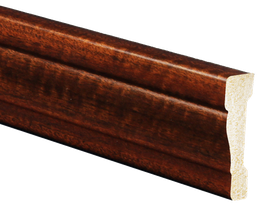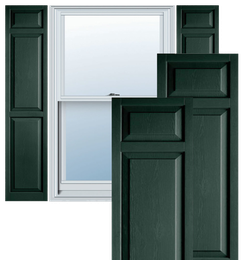FREE shipping on orders over $49!* Details
Molding and Trim
Best Seller
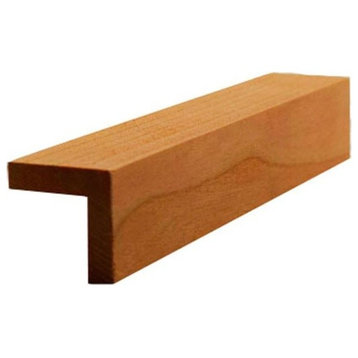
EWCG11 Corner Guard Trim Moulding, 7/8" x 7/8", Cherry, 94"by NewMouldings(2)
$32
Unfinished Solid Hardwood
- Thickness: 7/8 in.
- Width: 7/8 in.
- Length: 95 inches lengths.
- Application: Walls, Ceilings, Mantles, Columns
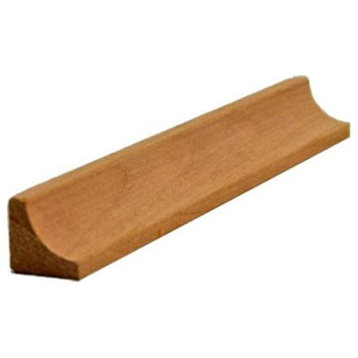
EWCC11 Cove Trim Moulding, 1/2" x 1/2", Cherry, 94"by NewMouldings(2)
$26
Unfinished Solid Hardwood
- Thickness: 1/2 in.
- Width: 1/2 in.
- Length: 95 inches lengths.
- Application: Walls, Ceilings, Mantles, Columns
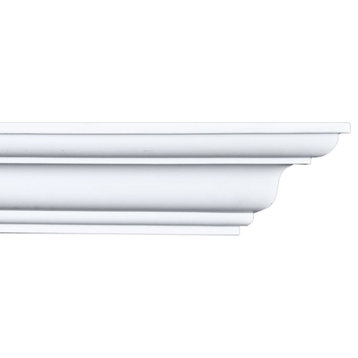
CM-1300 Crown Molding, Piece, Molding Pieceby Udecor(3)Sponsored
$29
Crown molding is manufactured with a dense architectural polyurethane compound (not Styrofoam) that allows it to be semi-flexible and 100% waterproof. This molding is delivered pre-primed for paint. It is installed with architectural adhesive and/or finish nails. It can also be finished with caulk, spackle and your choice of paint, just like wood or MDF. A major advantage of polyurethane is that it will not expand, constrict or warp over time with changes in temperature or humidity. It's safe to install in rooms with the presence of moisture like bathrooms and kitchens. This product will not encourage the growth of mold or mildew, and it will never rot.
- Safe to install indoors or outdoors
- Will not absorb moisture
- Is lightweight and durable against average wear
- Recommended tools for installation
- Nailgun & air compressor (set at 100 PSI or less)
- Miter saw
- Adhesive
- Spackle
- Caulk
- Tape measure
- Laser level
- Breadth: 4-3/4"
- Ceiling Height: 8' - 9'
- Height: 3-3/8"
- Depth : 3-3/8"
- Width: 94-1/2"
- Color: White Primer
- Material: Polyurethane
- Style: Smooth
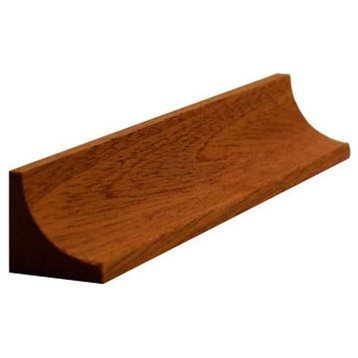
EWCC12 Cove Trim Moulding., 3/4" x 3/4", Sapele Mahogany, 94"by NewMouldings
$35
Unfinished Solid Hardwood
- Thickness: 3/4 in.
- Width: 3/4 in.
- Length: 95 inches lengths.
- Application: Cabinets, Kitchen, Laundry, Workshop
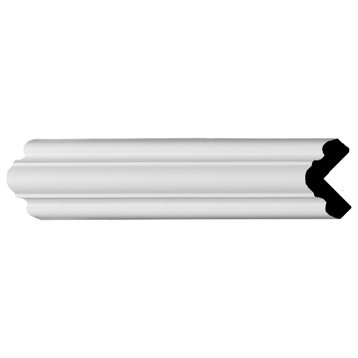
1.5"x1.5"Px2 1/8"Fx94.5" Bradford Smooth Corner Mouldingby Ekena Millwork(4)
SALE
$24$36
Free Shipping
Beautiful crown moulding is a great way to separate and define each room. With each design modeled after traditional plaster type mouldings, our lightweight polyurethane mouldings give the same rich detail, yet at a fraction of the cost. Most moulding profiles can be partnered with our do-it-yourself corner blocks that means no miter cutting for you, and most rooms can be completed in hours instead of days. Another benefit of polyurethane is it will not rot or crack, and is impervious to insect manifestations. It comes to you factory primed and ready for your paint, faux finish, gel stain, marbleizing and more.
- Modeled after original historical patterns and designs
- Solid urethane for maximum durability and detail
- Lightweight for quick and easy installation
- Factory primed and ready for paint or faux finish
- Can be cut, drilled, glued, or screwed
- Can be used on the interior or exterior
Best Seller
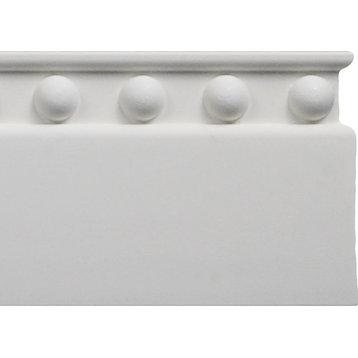
BB-9763 Molding, Molding Pieceby Udecor(1)Sponsored
$23
These baseboards are lightweight, yet very strong to withstand the impact of everyday living (vacuum cleaners, kids, etc.). The lengths make them easy to work with so you can install them quickly and they are very consistent so you can neatly finish any seams for a professional installation
Molding is manufactured with a dense architectural polyurethane compound (not Styrofoam) that allows it to be semi-flexible and 100% waterproof. This molding is delivered pre-primed for paint. It is installed with architectural adhesive and/or finish nails. It can also be finished with caulk, spackle and your choice of paint, just like wood or MDF. A major advantage of polyurethane is that it will not expand, constrict or warp over time with changes in temperature or humidity. It's safe to install in rooms with the presence of moisture like bathrooms and kitchens. This product will not encourage the growth of mold or mildew, and it will never rot.
Safe to install indoors or outdoors
Will not absorb moisture
Is lightweight and durable against average wear
Molding is manufactured with a dense architectural polyurethane compound (not Styrofoam) that allows it to be semi-flexible and 100% waterproof. This molding is delivered pre-primed for paint. It is installed with architectural adhesive and/or finish nails. It can also be finished with caulk, spackle and your choice of paint, just like wood or MDF. A major advantage of polyurethane is that it will not expand, constrict or warp over time with changes in temperature or humidity. It's safe to install in rooms with the presence of moisture like bathrooms and kitchens. This product will not encourage the growth of mold or mildew, and it will never rot.
Safe to install indoors or outdoors
Will not absorb moisture
Is lightweight and durable against average wear
- Recommended tools for installation
- Nailgun & air compressor (set at 100 PSI or less)
- Miter saw
- Adhesive
- Spackle
- Caulk
- Tape measure
- Laser level
- Style : Pellet
- Color : White Primer
- Material : Polyurethane
- Height : 4"
- Width : 1/2"
- Length : 96"
Best Seller
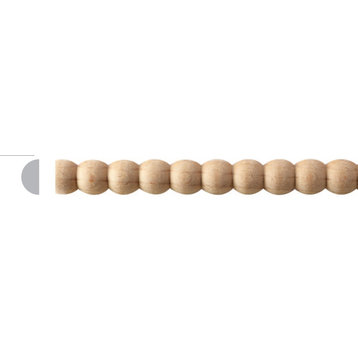
3/8" Diameter Half Round Bead Moulding, Set Of 10by CAMPBELL MOULDING(4)
$91
Free Shipping
This bead molding is made of steam beech. It is made in Italy. The order is 10 pieces per order--total of 30 ft
Best Seller
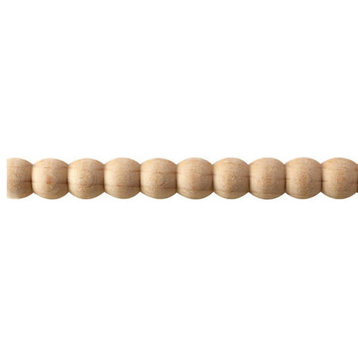
1/2" Diameter Bead Moldingby CAMPBELL MOULDING(6)
$103
Free Shipping
This half inch bead molding is made of steam beech wood. It is made in Italy. It sells as 10 pieces (30 ft) per order
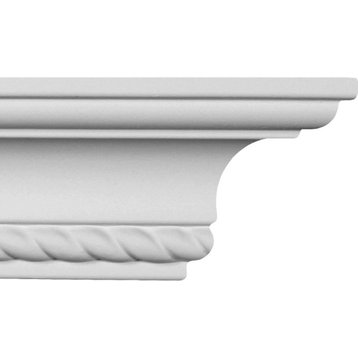
CM-1085 Crown Molding, Piece, Molding Pieceby Udecor(1)
$21
Crown molding is manufactured with a dense architectural polyurethane compound (not Styrofoam) that allows it to be semi-flexible and 100% waterproof. This molding is delivered pre-primed for paint. It is installed with architectural adhesive and/or finish nails. It can also be finished with caulk, spackle and your choice of paint, just like wood or MDF. A major advantage of polyurethane is that it will not expand, constrict or warp over time with changes in temperature or humidity. It's safe to install in rooms with the presence of moisture like bathrooms and kitchens. This product will not encourage the growth of mold or mildew, and it will never rot.
- Safe to install indoors or outdoors
- Will not absorb moisture
- Is lightweight and durable against average wear
- Recommended tools for installation
- Nailgun & air compressor (set at 100 PSI or less)
- Miter saw
- Adhesive
- Spackle
- Caulk
- Tape measure
- Laser level
- Breadth: 3-1/8"
- Ceiling Height: 8' - 9'
- Height: 2-1/4"
- Depth : 2-1/4"
- Width: 94-1/2"
- Color: White Primer
- Material: Polyurethane
- Style: Rope
Walnut Travertine Honed OG-2 Chair Rail Molding Trimby OTS
$15
Free Shipping
- Walnut Travertine Honed OG-2 Chair Rail Molding Trim
- Product Attributes
Item:
- Premium Quality 2 1/2" x 12" WALNUT TRAVERTINE DOUBLE-STEP, OG-2 CHAIR RAIL TRIM / MOLDING (HONED & FILLED)
Dimensions (per piece):
- 2 1/2" (Width) X 12" (Length) X 3/8" (Thickness / Thinnest Part ) - (ALL NOMINAL SIZES)
Material:
- Premium Turkish Walnut Travertine
Coverage:
- 1 pcs. = 1 ln. ft.- Price per pcs
Application Area(s):
- Commercial and Residential (Interior & Exterior), Shower, Backsplash, Countertop, Deck & Patio, Decorative, Floor, Wall
Minimum Purchase:
- 10 Pieces
Surface Finish:
- Filled & Honed (Matte)
Edge Finish:
- Honed (Straight-cut )
- Available Quantity
- All items are normally in stock in large quantities.
- Shipping Details / Cost
- Shipping is available within the 48 continental US States.
- SHIPPING IS FREE ON ALL ORDERS OF THIS ITEM, UNLESS STATED OTHERWISE.
- Special arrangements may be made for international buyers.
- For large orders and all other shipping related inquiries, please contact our shipping department.
- Ship / Lead Time
- All items are in stock. Normally ships within 1-2 Business days
- Item Location: Southern California (Anaheim, CA)
- Local Pickup: Available with appointment.
- Material Origin: TURKEY
- Manufacturer / Importer: OTS
- Please keep in mind that each piece of natural stone has unique features that vary it from the others in terms of color, texture and homogeneity. Expect to have some variation between individual pieces when ordering in large quantities.
- Installation of the product requires sealing products and these need to be purchased seperately. (Only the item described in the listing will be shipped out).
EWBC13 Traditional Base Cap Moulding, 11/16" x 1-3/8", Red Oak, 94"by NewMouldings(1)
$32
Unfinished Solid Hardwood
- Thickness: 11/16 in.
- Width: 1-3/8 in.
- Length: 95 inches
- Application: Baseboards, Wainscot
EWCR40 Cove Crown Moulding Trim, 3/4" x 3-3/4", Cherry, 94"by NewMouldings(3)
$57
Unfinished Solid Hardwood
- Thickness: 3/4 in.
- Width: 3-3/4 in.
- Height: 2-5/8 in.
- Length: 95 inches lengths.
- Projection: 2-1/2 in.
- Application: Walls, Ceilings, Mantles, Columns
CM-1163 Crown Molding, Piece, Molding Pieceby Udecor(2)Sponsored
$46
Crown molding is manufactured with a dense architectural polyurethane compound (not Styrofoam) that allows it to be semi-flexible and 100% waterproof. This molding is delivered pre-primed for paint. It is installed with architectural adhesive and/or finish nails. It can also be finished with caulk, spackle and your choice of paint, just like wood or MDF. A major advantage of polyurethane is that it will not expand, constrict or warp over time with changes in temperature or humidity. It's safe to install in rooms with the presence of moisture like bathrooms and kitchens. This product will not encourage the growth of mold or mildew, and it will never rot.
- Safe to install indoors or outdoors
- Will not absorb moisture
- Is lightweight and durable against average wear
- Recommended tools for installation
- Nailgun & air compressor (set at 100 PSI or less)
- Miter saw
- Adhesive
- Spackle
- Caulk
- Tape measure
- Laser level
- Breadth: 6"
- Ceiling Height: 10' - 11'
- Height: 5-1/2"
- Depth : 2-1/4"
- Width: 94-1/2"
- Color: White Primer
- Material: Polyurethane
- Style: Foliage
Best Seller
EWLR12 Kitchen Cabinet Light Rail Nose and Cove Moulding, 7/8" x 1-3/8", Cherryby NewMouldings(16)
$40
- Unfinished Solid Hardwood
- In Stock Item Ready to Ship
- Thickness: 7/8 in.
- Width: 1-3/8 in.
- Length: 95 inch lengths.
- Application: Cabinets, Kitchen
Best Seller
EWCR13 Colonial Crown Moulding Trim, 3/4" x 4-5/8", Poplar, 94"by NewMouldings(1)
$52
Unfinished Solid Hardwood
- Thickness: 3/4 in.
- Width: 4-5/8 in.
- Height: 3-5/8 in.
- Length: 95 inches lengths.
- Projection: 2-3/4 in.
- Application: Walls, Ceilings, Mantles, Columns
36" Bottom Width x 37 1/8" Top Width Bedford Crossheadby Ekena Millwork(72)
SALE
$51$183
Free Shipping
Remodelers, builders, and homeowners looking to enhance their next project by adding more curb appeal to the exterior of a home should consider crossheads. Crossheads are large casings that are typically placed at the top of a window, doorway or large entryway. Made of lightweight, yet durable high-density polyurethane, crossheads are easy for anyone to install. Feel free to choose from an amazing selection of sizes and style that will suit your project needs.
- Additional Dimensions: 3 1/2"H x 7/8"P
- Comes factory primed and ready for your paint or stain
- Easily install it with fully bonded adhesive or nails
- Perfect for exterior and interior applications
- Composed of high-density polyurethane, making it a durable yet lightweight product
- Moisture, rot and termite resistant
- Customize with keystones, pilasters and pediments for an extraordinary look
1 1/8"H x 3/8"P x 96"L Crendon Roped Panel Mouldingby Ekena Millwork(19)
$33
1 1/8"H x 3/8"P x 96"L Crendon Roped Panel Moulding. Our beautiful panel moulding and corners add a decorative, historic, feel to walls, ceilings, and furniture pieces. They are made from a high density urethane which gives each piece the unique details that mimic that of traditional plaster and wood designs, but at a fraction of the weight. This means a simple and easy installation for you. The best part is you can make your own shapes and sizes by simply cutting the moulding piece down to size, and then butting them up to the decorative corners. These are also commonly used for an inexpensive wainscot look.
Wood Baseboard Heater Cover, 6' Length, Shaker, Closed Endcapsby Vent and Cover
$360
Free Shipping
Finally a wood baseboard cover solution that looks great, installs in minutes, and doesn't require any expensive custom carpentry or hired help.
This craftsman style baseboard cover has a recessed center panel and is defined by its clean lines and simple practicality that is popular in custom cabinetry.
Our quality handcrafted wood baseboard covers easily transform your existing hot water baseboard heaters from old and rusty to elegant and stylish. Installation takes mere minutes using only a standard screwdriver.
Each cover kit uses 3/4" thick, moisture resistant, furniture grade MDF (commonly used in cabinetry and baseboard applications), chosen for its consistent strength and stability. Panels are finished in a White satin finish to seal and prevent warping.
Not feeling the white finish? Let your inner Van Gogh run wild! Our wood baseboard covers can easily be painted with any custom color of your choosing using a roller or spray paint application for a custom look. With a simple light sanding these baseboard covers will be ready to paint any color you desire.
This craftsman style baseboard cover has a recessed center panel and is defined by its clean lines and simple practicality that is popular in custom cabinetry.
Our quality handcrafted wood baseboard covers easily transform your existing hot water baseboard heaters from old and rusty to elegant and stylish. Installation takes mere minutes using only a standard screwdriver.
Each cover kit uses 3/4" thick, moisture resistant, furniture grade MDF (commonly used in cabinetry and baseboard applications), chosen for its consistent strength and stability. Panels are finished in a White satin finish to seal and prevent warping.
Not feeling the white finish? Let your inner Van Gogh run wild! Our wood baseboard covers can easily be painted with any custom color of your choosing using a roller or spray paint application for a custom look. With a simple light sanding these baseboard covers will be ready to paint any color you desire.
SPECIFICATIONS
- Each kit contains one front panel, one top panel, 2 end caps, wall mounting brackets and all screws/fasteners required for assembly and installation--all you need is a standard screwdriver.
- Easily fits over your original baseboard heater - just remove the existing front panel and end caps
- High quality MDF with a satin white finish
- DIY installation, no custom carpentry or hired help
- Available in lengths from 3ft - 6ft
- End Caps are included, and come in 3 different styles depending on your particular needs
- Some assembly required
- Made in Canada
- *Not intended for use over electric baseboard heaters
- END CAPS
- End Caps are included, and come in 3 different styles depending on your particular needs:
- Closed End Cap: The most common End Cap solution and work for most applications where the copper pipe bends down into the floor or the wall behind the heater.
- Notched End Cap:The notched End Cap comes with a pre-notched cutout to accommodate your existing baseboard trim for a perfect fit.
- Open End Cap: Used on the rare occasion when the copper pipe continues on straight without bending--the open space at the side of the End Cap allows the copper pipe to exit.
PRODUCT DIMENSIONS
- Inside Depth (in.):3.5
- Overall Depth (in.): 4.25*
- Inside Height (in.):9.25
- Overall Height (in.):10
- Inside Width (in.):74
- Overall Width (in.):75.5
- Does NOT include overhang which adds 1/2" overall
Best Seller
EWCR39 Cove Crown Moulding Trim, 3/4" x 2-5/8", Poplar, 94"by NewMouldings(2)
$40
Unfinished Solid Hardwood
- Thickness: 3/4 in.
- Width: 2-5/8 in.
- Height: 1-7/8 in.
- Length: 95 inches lengths.
- Projection: 1-3/4 in.
- Application: Walls, Ceilings, Mantles, Columns
Best Seller
FM-5518 Flat Molding, Molding Pieceby Udecor(4)Sponsored
$25
Molding is manufactured with a dense architectural polyurethane compound (not Styrofoam) that allows it to be semi-flexible and 100% waterproof. This molding is delivered pre-primed for paint. It is installed with architectural adhesive and/or finish nails. It can also be finished with caulk, spackle and your choice of paint, just like wood or MDF. A major advantage of polyurethane is that it will not expand, constrict or warp over time with changes in temperature or humidity. It's safe to install in rooms with the presence of moisture like bathrooms and kitchens. This product will not encourage the growth of mold or mildew, and it will never rot.
Safe to install indoors or outdoors
Will not absorb moisture
Is lightweight and durable against average wear
Safe to install indoors or outdoors
Will not absorb moisture
Is lightweight and durable against average wear
- Recommended tools for installation
- Nailgun & air compressor (set at 100 PSI or less)
- Miter saw
- Adhesive
- Spackle
- Caulk
- Tape measure
- Laser level
- Style : Foliage
- Color : White Primer
- Material : Polyurethane
- Height : 4-3/4"
- Width : 1/2"
- Length : 96"
EWSC12 Solid Crown Moulding, 1-1/8" x 2-1/4", Cherry, 94"by NewMouldings(1)
$53
Unfinished Solid Hardwood
- Thickness: 1-1/8 in.
- Width: 2-1/4 in.
- Length: 95 inches .
- Application: Walls, Ceilings, Mantles, Columns
1 1/8"Hx1 1/8"Px1 1/2"Fx94 1/2"L Traditional Crown Mouldingby Ekena Millwork(7)
SALE
$19$32
Free Shipping
Crisp lines lend a modern or traditional style, while intricate and elaborate patterns provide elegant detail enhancing the look of any room. You benefit by saving time and money with our corresponding no-miter corner blocks that involve no cutting and less labor, available for select moulding profiles. You can relax in your new space because our mouldings are the highest quality, environmentally friendly material that is essentially maintenance free. Complete projects in hours instead of days, with seamless hassle-free installation. Your new look is sure to evoke envy and inspire everyone to follow suit.
- Lightweight for quick and easy installation
- Solid urethane for maximum durability and minimal upkeep
- Sharp design clarity and high quality, limitless pattern options
- Can be cut, drilled, glued or screwed with common tools
- Factory primed and ready for paint or faux finish
- Impervious to moisture and rot
Best Seller
MP10069 Corner Shield, 2-3/8"x48", Vinyl Construction, White, 6 packby Prime-Line Products(398)
$84
Free Shipping
These corner shields are constructed of extruded vinyl and come white in color. This item includes a total of six (6) corner shields, and they feature 2-3/8 in. x 2-3/8 in. wide leafs at lengths of 48 in. each. Corner guards like these protect the edges of finished wall corners, designed to prevent chipped paint, tearing of wallpaper and unsightly buildup of fingerprints. These corner shields are solid in construction and come without any pre-perforated installation holes. Use of dual-sided tape is recommended for quick and simple installations, but not included. These corner shields are easy to install and are used by many.
- Used to prevent chipping of paint, tearing of wallpaper and fingerprint build up
- These corner shields feature 2-3/8 in. wide leafs and come in 48 in. lengths
- These guards come white in color
- Constructed of long-lasting, extruded vinyl. Installation holes not pre-drilled
- These corner shields do not include dual sided mounting tape, or any other installation fasteners
- For further dimensional information, please see the line drawing
Light Hardwood Edge and Corner Guards Unfinished 1" Diameter Corner Protectorby Renovators Supply Manufacturing(19)
$40
Free Shipping
Item 92714 TRADITIONAL LIGHT UNFINISHED BEECHWOOD CORNER GUARD
Using a corner guard in home interior design gives a unique touch to the outlook of the entire room. These decorative sturdy corner guards are made of durable Beechwood material. Unfinished wooden Corner protectors come in light colour, sanded, ready to be painted or stained. These are sold in two parts for the sake of shipping, both the parts can be easily joined by Dowel Slide On Connection Installation.
Save money on retouching your corner, by placing these corner protectors in your home. Save your kids from hitting the corners and injuring them. Renovators Supply Manufacturing offers you great value products for your money and a perfect way to spend wisely.
Using a corner guard in home interior design gives a unique touch to the outlook of the entire room. These decorative sturdy corner guards are made of durable Beechwood material. Unfinished wooden Corner protectors come in light colour, sanded, ready to be painted or stained. These are sold in two parts for the sake of shipping, both the parts can be easily joined by Dowel Slide On Connection Installation.
FEATURES
- Decorative Corner guard is made of Beechwood
- Has a 90-degree notch for easy mounting
- Shipped in two pieces
- Measures 39.5 inches in height and 1 inch in diameter
- Comes Unfinished and Sanded
- Light in colour, Paint or Stain like your preference
- INSTALLATION INSTRUCTIONS
- GLUE = Use glue in the centre to stick it onto the corners and press firmly. Easy way to install, but glue may damage to wall paint when removed.
- NAILS = Secure corner guards on the walls using two nails for each part. Drill pilot holes slightly smaller than nails and cover it with putty and paint/stain for a finished look.
Save money on retouching your corner, by placing these corner protectors in your home. Save your kids from hitting the corners and injuring them. Renovators Supply Manufacturing offers you great value products for your money and a perfect way to spend wisely.
3 1/2"Hx3 1/2"Px4 3/4"Fx94 1/2"L, Cove Dentil Crown Mouldingby Ekena Millwork(153)
SALE
$45$60
Crisp lines lend a modern or traditional style, while intricate and elaborate patterns provide elegant detail enhancing the look of any room. You benefit by saving time and money with our corresponding no-miter corner blocks that involve no cutting and less labor, available for select moulding profiles. You can relax in your new space because our mouldings are the highest quality, environmentally friendly material that is essentially maintenance free. Complete projects in hours instead of days, with seamless hassle-free installation. Your new look is sure to evoke envy and inspire everyone to follow suit.
- Lightweight for quick and easy installation
- Solid urethane for maximum durability and minimal upkeep
- Sharp design clarity and high quality, limitless pattern options
- Can be cut, drilled, glued or screwed with common tools
- Factory primed and ready for paint or faux finish
- Impervious to moisture and rot
1.5"x1.5"Px2 1/8"Fx94.5" Cole Smooth Corner Mouldingby Ekena Millwork(7)
SALE
$23$34
Free Shipping
Beautiful crown moulding is a great way to separate and define each room. With each design modeled after traditional plaster type mouldings, our lightweight polyurethane mouldings give the same rich detail, yet at a fraction of the cost. Most moulding profiles can be partnered with our do-it-yourself corner blocks that means no miter cutting for you, and most rooms can be completed in hours instead of days. Another benefit of polyurethane is it will not rot or crack, and is impervious to insect manifestations. It comes to you factory primed and ready for your paint, faux finish, gel stain, marbleizing and more.
- Modeled after original historical patterns and designs
- Solid urethane for maximum durability and detail
- Lightweight for quick and easy installation
- Factory primed and ready for paint or faux finish
- Can be cut, drilled, glued, or screwed
- Can be used on the interior or exterior
BB-9776 Molding, Molding Pieceby UdecorSponsored
$27
These baseboards are lightweight, yet very strong to withstand the impact of everyday living (vacuum cleaners, kids, etc.). The lengths make them easy to work with so you can install them quickly and they are very consistent so you can neatly finish any seams for a professional installation
Molding is manufactured with a dense architectural polyurethane compound (not Styrofoam) that allows it to be semi-flexible and 100% waterproof. This molding is delivered pre-primed for paint. It is installed with architectural adhesive and/or finish nails. It can also be finished with caulk, spackle and your choice of paint, just like wood or MDF. A major advantage of polyurethane is that it will not expand, constrict or warp over time with changes in temperature or humidity. It's safe to install in rooms with the presence of moisture like bathrooms and kitchens. This product will not encourage the growth of mold or mildew, and it will never rot.
Safe to install indoors or outdoors
Will not absorb moisture
Is lightweight and durable against average wear
Molding is manufactured with a dense architectural polyurethane compound (not Styrofoam) that allows it to be semi-flexible and 100% waterproof. This molding is delivered pre-primed for paint. It is installed with architectural adhesive and/or finish nails. It can also be finished with caulk, spackle and your choice of paint, just like wood or MDF. A major advantage of polyurethane is that it will not expand, constrict or warp over time with changes in temperature or humidity. It's safe to install in rooms with the presence of moisture like bathrooms and kitchens. This product will not encourage the growth of mold or mildew, and it will never rot.
Safe to install indoors or outdoors
Will not absorb moisture
Is lightweight and durable against average wear
- Recommended tools for installation
- Nailgun & air compressor (set at 100 PSI or less)
- Miter saw
- Adhesive
- Spackle
- Caulk
- Tape measure
- Laser level
- Style : Rope
- Color : White Primer
- Material : Polyurethane
- Height : 4-3/4"
- Width : 1/2"
- Length : 96"
Best Seller
Polystyrene OG Casing Moulding, Set of 5, 11/16"x2-3/8"x84", Majestic Oakby Inteplast Building Products(16)
$81
Free Shipping
Inteplast Mouldings are the ideal way for you to add style and beauty to your home. Our mouldings are lightweight and come prefinished making them an easy weekend project. Inteplast Woodgrain Mouldings feature a rich wood grain texture with colors that give the natural appearance of expensive, hand-finished mouldings without the hassle of labor-intensive finishing processes making them the perfect accent for your room.
- Prefinished, no sanding, priming, painting or staining needed
- Majestic oak woodgrain finish in a convenient 84-inches long
- Moisture-resistant, ideal for use in bathrooms, laundry rooms and kitchens
- Resistant to damage from insects
- Easy to cut, nail and install
- No warps or voids - use with confidence
3 1/2"Hx2 1/4"Px4 1/4"Fx94 1/2"L Eris Crown Mouldingby Ekena Millwork(2)
SALE
$34$41
Crisp lines lend a modern or traditional style, while intricate and elaborate patterns provide elegant detail enhancing the look of any room. You benefit by saving time and money with our corresponding no-miter corner blocks that involve no cutting and less labor, available for select moulding profiles. You can relax in your new space because our mouldings are the highest quality, environmentally friendly material that is essentially maintenance free. Complete projects in hours instead of days, with seamless hassle-free installation. Your new look is sure to evoke envy and inspire everyone to follow suit.
- Lightweight for quick and easy installation
- Solid urethane for maximum durability and minimal upkeep
- Sharp design clarity and high quality, limitless pattern options
- Can be cut, drilled, glued or screwed with common tools
- Factory primed and ready for paint or faux finish
- Impervious to moisture and rot
EWCR11 Colonial Crown Moulding Trim, 3/4" x 2-5/8", Red Oak, 94"by NewMouldings(2)
$42
- Unfinished Solid Hardwood
- Length: 95 inch or 5" Sample.
- Thickness: 3/4 in.
- Width: 2-5/8 in.
- Wall Height: 1-7/8 in.
- Ceiling Projection: 1-3/4 in.
- Application: Walls, Ceilings, Mantles, Columns
BB-9750 Molding, Molding Pieceby Udecor(2)
$34
These baseboards are lightweight, yet very strong to withstand the impact of everyday living (vacuum cleaners, kids, etc.). The lengths make them easy to work with so you can install them quickly and they are very consistent so you can neatly finish any seams for a professional installation
Molding is manufactured with a dense architectural polyurethane compound (not Styrofoam) that allows it to be semi-flexible and 100% waterproof. This molding is delivered pre-primed for paint. It is installed with architectural adhesive and/or finish nails. It can also be finished with caulk, spackle and your choice of paint, just like wood or MDF. A major advantage of polyurethane is that it will not expand, constrict or warp over time with changes in temperature or humidity. It's safe to install in rooms with the presence of moisture like bathrooms and kitchens. This product will not encourage the growth of mold or mildew, and it will never rot.
Safe to install indoors or outdoors
Will not absorb moisture
Is lightweight and durable against average wear
Molding is manufactured with a dense architectural polyurethane compound (not Styrofoam) that allows it to be semi-flexible and 100% waterproof. This molding is delivered pre-primed for paint. It is installed with architectural adhesive and/or finish nails. It can also be finished with caulk, spackle and your choice of paint, just like wood or MDF. A major advantage of polyurethane is that it will not expand, constrict or warp over time with changes in temperature or humidity. It's safe to install in rooms with the presence of moisture like bathrooms and kitchens. This product will not encourage the growth of mold or mildew, and it will never rot.
Safe to install indoors or outdoors
Will not absorb moisture
Is lightweight and durable against average wear
- Recommended tools for installation
- Nailgun & air compressor (set at 100 PSI or less)
- Miter saw
- Adhesive
- Spackle
- Caulk
- Tape measure
- Laser level
- Style : Plain
- Color : White Primer
- Material : Polyurethane
- Height : 6"
- Width : 1/2"
- Length : 96"
Best Seller
EWHR11 Half Round Moulding Trim, 3/8" x 3/4", Sapele Mahogany, 94"by NewMouldings(1)
$35
Unfinished Solid Hardwood
- Thickness: 3/8 in.
- Width: 3/4 in.
- Length: 95 Inches .
- Application: Cabinet, Window, Decorative
5 1/2"Hx5 1/8"Px7 1/2"Fx94 1/2"L Dylan Crown Mouldingby Ekena Millwork(2)
$64
Free Shipping
Crisp lines lend a modern or traditional style, while intricate and elaborate patterns provide elegant detail enhancing the look of any room. You benefit by saving time and money with our corresponding no-miter corner blocks that involve no cutting and less labor, available for select moulding profiles. You can relax in your new space because our mouldings are the highest quality, environmentally friendly material that is essentially maintenance free. Complete projects in hours instead of days, with seamless hassle-free installation. Your new look is sure to evoke envy and inspire everyone to follow suit.
- Lightweight for quick and easy installation
- Solid urethane for maximum durability and minimal upkeep
- Sharp design clarity and high quality, limitless pattern options
- Can be cut, drilled, glued or screwed with common tools
- Factory primed and ready for paint or faux finish
- Impervious to moisture and rot
Best Seller
FM-5551 Flat Molding, Molding Pieceby Udecor(2)Sponsored
$68
Molding is manufactured with a dense architectural polyurethane compound (not Styrofoam) that allows it to be semi-flexible and 100% waterproof. This molding is delivered pre-primed for paint. It is installed with architectural adhesive and/or finish nails. It can also be finished with caulk, spackle and your choice of paint, just like wood or MDF. A major advantage of polyurethane is that it will not expand, constrict or warp over time with changes in temperature or humidity. It's safe to install in rooms with the presence of moisture like bathrooms and kitchens. This product will not encourage the growth of mold or mildew, and it will never rot.
Safe to install indoors or outdoors
Will not absorb moisture
Is lightweight and durable against average wear
Safe to install indoors or outdoors
Will not absorb moisture
Is lightweight and durable against average wear
- Recommended tools for installation
- Nailgun & air compressor (set at 100 PSI or less)
- Miter saw
- Adhesive
- Spackle
- Caulk
- Tape measure
- Laser level
- Style : Foliage
- Color : White Primer
- Material : Polyurethane
- Height : 7"
- Width : 1"
- Length : 96"
3"H x 5/8"P x 94 1/2"L Bedford Chair Railby Ekena Millwork(11)
SALE
$29$40
Free Shipping
Our beautiful chair rail adds a decorative, historic, feel to walls, ceilings and furniture pieces. They are made from a high density urethane which gives each piece the unique details that mimic that of traditional plaster and wood designs, but at a fraction of the weight. This means a simple and easy installation for you. These are also commonly used for an inexpensive wainscot look.
- Modeled after original historical patterns and designs
- Solid urethane for maximum durability and detail
- Lightweight for quick and easy installation
- Factory primed and ready for paint or faux finish
- Can be cut, drilled, glued, or screwed
- Can be used on the interior or exterior
4"H x 3/8"P x 94 1/2"L Barcelona Baseboard Mouldingby Ekena Millwork(185)
SALE
$45$104
Beautiful baseboard is a great way to separate and define each room. With each design modeled after traditional plaster type mouldings, our lightweight polyurethane mouldings give the same rich detail, yet at a fraction of the cost. Another benefit of polyurethane is it will not rot or crack, and is impervious to insect manifestations. It comes to you factory primed and ready for your paint, faux finish, gel stain, marbleizing and more.
- Modeled after original historical patterns and designs
- Solid urethane for maximum durability and detail
- Lightweight for quick and easy installation
- Factory primed and ready for paint or faux finish
- Can be cut, drilled, glued, or screwed
- Can be used on the interior or exterior
Millwork doesn’t always get the recognition it deserves. A room looks unfinished without it, but when it’s present, it’s not necessarily the first thing you notice. Adding crown molding or baseboard trim not only disguises the intersection of two materials, but it also adds personal style to a home. If you are looking to upgrade, switch or enhance your home’s aesthetic, your molding and millwork is the perfect small place to make a big impact. Check out the commonly asked questions below to help decide on a new chair rail, coving, window trim or all of the above.
When choosing crown molding, take into account the other architectural elements in your home. Is your home classic craftsman style or very traditional? Knowing the current style will help you narrow down the trim that will work best. For more traditional styles, something ornate, like bead molding or cornices with lots of curves and foliage, will fit right in. Moldings that have clean, crisp lines will give more of a built-by-hand craftsman feel. A more contemporary way to use this type of millwork is to incorporate it with your lighting. When deciding on a design, don’t forget to consider the shadows that will be cast — convex and concave shapes will place shadows differently on the ceiling or wall.
Baseboard trim tends to get kicked to the side amongst other millwork, but it’s likely the most important. Baseboards themselves typically are perpendicular to the floor, which creates a harsh angle (not to mention good spots for dust and dirt to collect). Shoe and quarter round molding will help soften that angle. Shoe molding is the narrower of the two curved options and is often preferred over quarter round, which is literally a quarter of a circle. Assess your current baseboards, architectural elements and size of the space to determine which base molding will work best.
Walls and Ceilings: Chair rail molding is placed approximately 36 inches up from the floor and serves to prevent chair backs from hitting the wall. A chair rail is also a great way to create a visual break in the wall or help transition from wallpaper to paint. A picture rail, placed high on the wall with a rounded top edge, is a common feature associated with plaster walls, which would be otherwise ruined by hanging picture frames with nails. Wall trim, also known as panel molding, is a good way to break up large spaces. Use it to create depth and dimension on flat surfaces and add traditional accent to plain walls. The same effect can be applied to ceilings as well.
Windows and Doors: These two important places greatly benefit from a little millwork. Window casing and door casing often gets overlooked — as they are more of a necessity than other details — but both are easy places to add style and value to your home. Window and door trim can be as basic or intricate as you desire, as long as it covers the gaps between the wall and jamb.
How do I choose crown molding?
When choosing crown molding, take into account the other architectural elements in your home. Is your home classic craftsman style or very traditional? Knowing the current style will help you narrow down the trim that will work best. For more traditional styles, something ornate, like bead molding or cornices with lots of curves and foliage, will fit right in. Moldings that have clean, crisp lines will give more of a built-by-hand craftsman feel. A more contemporary way to use this type of millwork is to incorporate it with your lighting. When deciding on a design, don’t forget to consider the shadows that will be cast — convex and concave shapes will place shadows differently on the ceiling or wall.
How do I choose baseboard molding?
Baseboard trim tends to get kicked to the side amongst other millwork, but it’s likely the most important. Baseboards themselves typically are perpendicular to the floor, which creates a harsh angle (not to mention good spots for dust and dirt to collect). Shoe and quarter round molding will help soften that angle. Shoe molding is the narrower of the two curved options and is often preferred over quarter round, which is literally a quarter of a circle. Assess your current baseboards, architectural elements and size of the space to determine which base molding will work best.
Where else can I use molding and millwork?
Walls and Ceilings: Chair rail molding is placed approximately 36 inches up from the floor and serves to prevent chair backs from hitting the wall. A chair rail is also a great way to create a visual break in the wall or help transition from wallpaper to paint. A picture rail, placed high on the wall with a rounded top edge, is a common feature associated with plaster walls, which would be otherwise ruined by hanging picture frames with nails. Wall trim, also known as panel molding, is a good way to break up large spaces. Use it to create depth and dimension on flat surfaces and add traditional accent to plain walls. The same effect can be applied to ceilings as well.
Windows and Doors: These two important places greatly benefit from a little millwork. Window casing and door casing often gets overlooked — as they are more of a necessity than other details — but both are easy places to add style and value to your home. Window and door trim can be as basic or intricate as you desire, as long as it covers the gaps between the wall and jamb.








